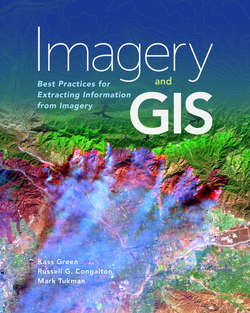Читать книгу Imagery and GIS - Kass Green - Страница 28
На сайте Литреса книга снята с продажи.
Collection Characteristics
ОглавлениеImage collection characteristics are affected by the remote sensing system used to collect the imagery. Remote sensing systems comprise sensors that capture data about objects from a distance, and platforms that support and transport sensors. For example, humans are remote sensing systems because our bodies, which are platforms, support and transport our sensors—our eyes, ears, and noses—which detect visual, audio, and olfactory data about objects from a distance. Our brains then identify/classify this remotely sensed data into information about the objects. This section explores sensors first, and then platforms. It concludes by discussing how sensors and platforms combine to determine imagery collection characteristics.
A platform is defined by the Glossary of the Mapping Sciences (ASCE, 1994) as “A vehicle holding a sensor.” Platforms include satellites, piloted helicopters and fixed-wing aircraft, unmanned aerial systems (UASs), kites and balloons, and earth-based platforms such as traffic-light poles and boats. Sensors are defined as devices or organisms that respond to stimuli. Remote sensors reside on platforms and respond “to a stimulus without being in contact with the source of the stimulus” (ASCE, 1994). Examples of remote sensing systems include our eyes, ears, and noses; the camera in your phone; a video camera recording traffic or ATM activity; sensors on satellites; and cameras on UASs, helicopters, or airplanes.
Imagery is acquired from terrestrial, aircraft, marine, and satellite platforms equipped with either analog (film) or digital sensors that measure and record electromagnetic energy.1 Because humans rely overwhelmingly on our eyes to perceive and understand our surroundings, most remote sensing systems capture imagery that extends our ability to see by measuring the electromagnetic energy reflected or emitted from an object. Electromagnetic energy is of interest because different types of objects reflect and emit different intensities and wavelengths of electromagnetic energy, as shown in figure 3.1. Therefore, measurements of electromagnetic energy can be used to identify features on the imagery and to differentiate diverse classes of objects from one another to make a map.
Figure 3.1. Comparison of example percent reflectance of different types of objects across the electromagnetic spectrum (esriurl.com/IG31)
The type of sensor used to capture energy determines which portions of the electromagnetic spectrum the sensor can measure (the imagery’s spectral resolution) and how finely it can discriminate between different levels of energy (its radiometric resolution). The type of platform employed influences where the sensor can travel, which will affect the temporal resolution of the imagery. The remote sensing system—the combination of the sensor and the platform—impacts the detail perceivable by the system, the imagery’s spatial resolution, the viewing angle of the imagery, and the extent of landscape viewable in each image.
